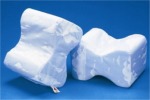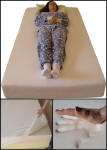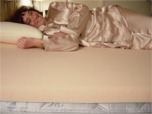Sponsored by:
Mattress For All Sleeping Positions
A mattress that properly supports the body should be solid enough to not cave
inward with body pressure and yet have enough give to allow contouring of the
body. This is especially important with side sleepers, as a lot of
pressure is placed on the shoulders and hips. While back sleepers can get
away with a more firm mattress, the contouring of the body that occurs with a
mattress that gives with pressure applied will hold the body in a more proper
position for a comfortable sleep. Sleeping on your stomach can be
irritating to your neck and back due to the complete rotation of the neck to one
side while in this position. While it is not recommended that you sleep on
your stomach, if you still move around to all positions, or if you have a bed
mate which sleeps in a different position than you, keep the following in
mind:
Pick a mattress that is soft enough on the surface to substitute for
the lack of a pillow when on your stomach, as using a pillow in this position
will only push the neck further to a rotated and backward extended
position. This compression can be a source of irritation to the joints and
soft tissue of the spine. Don't be fooled by all those promotions which
state that firm mattresses are necessary for good support. Firm mattresses
work better for back sleepers than they do for side or stomach sleepers.
This does not imply that a soft mattress will be more beneficial. A
mattress that gives too much or bends inwardly will not be supportive enough for
the spine. The best kind of mattress for all position sleepers will have a
supportive density, but also have enough give to conform to the bumps and curves
of the body, with a softer overlay to substitute for the lack of a pillow and
provide more comfort for the muscles and joints.
A memory foam density
will accomplish this the most effectively (see pictures below). Memory
foam is a visco-elastic, temperature sensitive polyurethane foam that has the
ability to compress, but then slowly come back to its original shape.
Therefore memory foam does not place nearly the same resistance on the joints as
spring, air, and other materials that bounce back more rapidly. The more
memory foam heats up, the more soft it becomes. Memory foam mattresses are
usually composed of 3 inches of the temperature sensitive visco-elastic foam,
over 5 inches of regular polyurethane foam. Memory foam is usually found
in 3-5lb. densities. 5lb. memory foam is more temperature sensitive,
heavier, usually stiffer and bounces back more slowly (see right side below for
an actual example of 5lb. memory foam). 4lb. memory foam will therefore be
less temperature sensitive and less dense, more soft, less expensive, but also a
little less supportive. There is a bed now that combines the two, so that
the top layer is a 4lb. density and the next two inches are a 5lb. density.
This will give you that immediate soothing sensation, but still be a little
firmer underneath for better support (see left side picture below for
recommended 3-layer memory foam mattress).
Certain types of latex foam will also be soft enough to contour the body, but
provide a bit more of a spring effect. This material can be combined well with
memory foam to make up a mattress, but neither substance should be used in the
bottom base layer of the mattress. This is because you never want to sink too
much into the mattress, as this would cause a folding effect of your body and
you would loose support. For this reason, people who are primarily side
sleepers can utilize more of the memory foam and latex material. This is
due to the fact that the shoulders and hips stick out farther, and therefore
need more contouring if you are going to attempt to evenly distribute your
weight over the whole of the mattress. People who are primarily back sleepers
may need more of a firmer support material underneath the latex and/or memory
foam, as less contouring is needed. If your current mattress is still solid enough, you may only need a memory foam
topper (center picture below).
When lying on your
stomach, always put a pillow to wedge under one side of the pelvis and same side
leg, thereby limiting the amount of rotation of the upper spine. Back sleepers
can place a pillow under their legs to reduce traction on the spine. When
lying on your side, always put a pillow or orthopedic leg spacer between your
knees to prevent rotation of the pelvis and spine. We recommend the leg
spacer below, as it helps prevent torque on the spine from pelvic rotation when
you are on your side, while moving with your body if you roll on your back (see
picture below). This measure will
combine to keep your spine in a more correct alignment while sleeping. While
back sleeping is still the most supportive position for the spine, and stomach
sleeping will still have the potential to irritate the muscles and joints, these
tips should combine to keep your spine in a more correct alignment while
sleeping.

Click Here to to purchase the recommended
orthopedic leg spacer and memory foam mattress
for your spine found at Relief-Mart.


(3-layer Memory foam mattress)
(Memory foam topper)
(Memory Foam in action)
Click here to purchase the recommended Memory Foam Mattresses
and Toppers
found at Relief-Mart and
Selectabed.com

